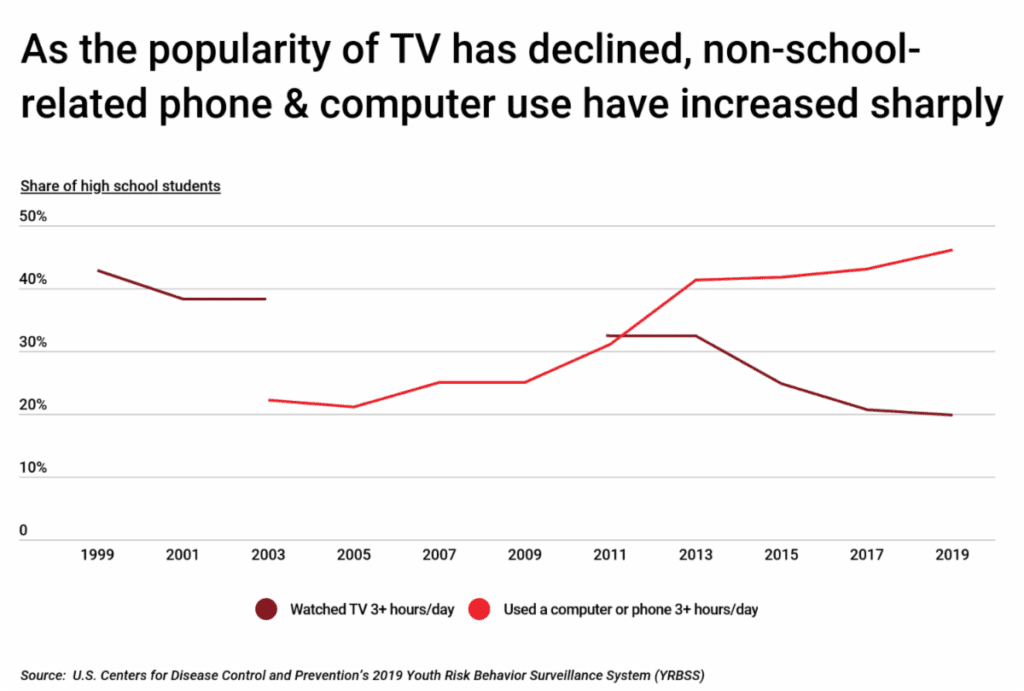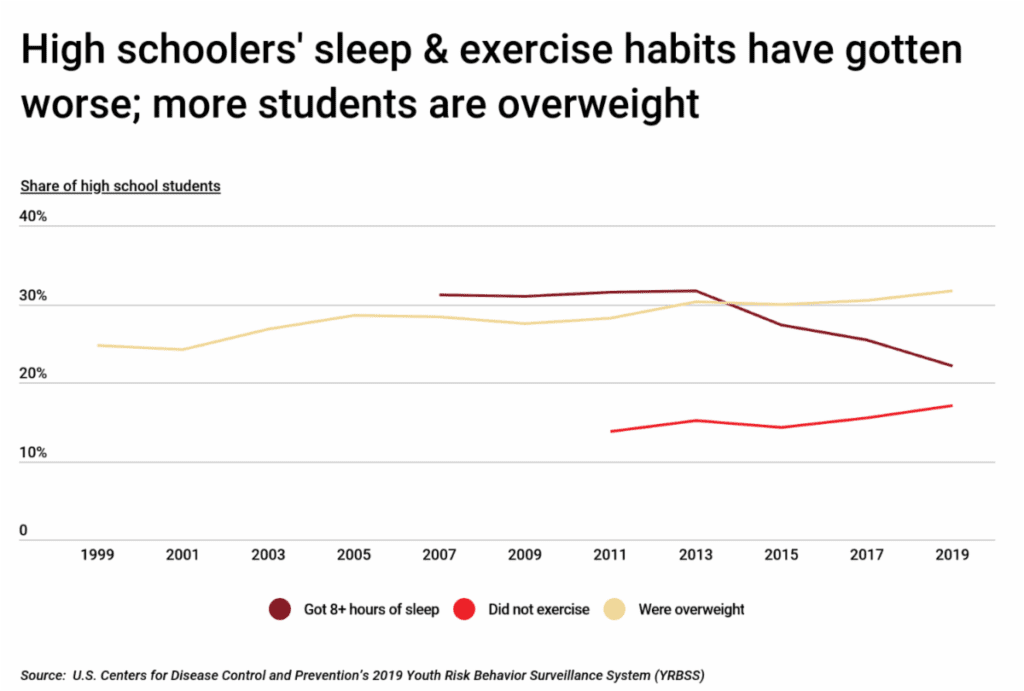19.4% of PA High School Students Watch 3+ hours of TV a Day
The COVID-19 pandemic dramatically increased the amount of time young people like high school students spent in front of screens. With classroom instruction shifted online and in-person social activities limited, children and teens spent more time than ever in front of computers, phones, TV, and other devices. According to one study, screen time doubled for adolescents during the pandemic, from 3.8 hours to 7.7 hours per day.
Related Article: Do Better in School By Getting Iron and Pumping Iron
The unique conditions of the pandemic made increased screen time a practical necessity for young people. But this reality also complicated a longtime conundrum for families: the right amount of time for children to spend with television, computers, phones, and tablets. For decades, parents and caregivers have feared adverse effects of technology on students’ physical and mental health, socialization, and cognitive ability while also recognizing the need to allow high school students to engage with modern life.

The nature of this challenge has shifted over the last generation, as time spent with television has declined and time spent with computers, phones, and tablets has risen. Computers and phones have clearly taken the place of television as a source of preoccupation for teenagers: in 1999, 42.8% of high school students reported watching television more than three hours per day, but that number is now only 19.8%. In 2003, only 22.1% of high school students used a computer or phone more than three hours per day, but that figure has more than doubled since then, to 46.1% in 2019. These numbers began to accelerate dramatically following the release of the iPhone in 2007 and the ensuing boom in the smartphone market.

These recent trends are somewhat concerning because of simultaneous shifts in students’ health. From 1999 to 2019, the share of high school students who were considered overweight or obese rose from 24.7% to 31.6%. The share of high school students getting more than 8 hours of sleep a night declined from 31.1% in 2007 to 22.1% in 2019, while the percentage of high school students who did not exercise increased from 13.8% in 2011 to 17% in 2019. And health researchers have found evidence to suggest that these phenomena are linked with increased device usage: students who use smartphones the most are much more likely to be obese, and screen time contributes to insomnia by disrupting the body’s natural circadian rhythms.

While the decline in TV watching compared to computer and phone usage is a nationwide phenomenon, some states still have relatively high rates of television usage among high school students. Many of these states are located in the Southern U.S., led by Mississippi (27.6% of high school students watching more than three hours of TV per day), Louisiana (24.6%), and Tennessee (23.5%).
The data used in this analysis is from the U.S. Centers for Disease Control and Prevention’s Youth Risk Behavior Surveillance System. To determine the states where high school students watch the most television, researchers at KTCB calculated the percentage of high school students who reported watching three or more hours of television on an average school day. In the event of a tie, non-school computer and phone use on an average school day—including social media, video games, texting, and watching videos—was considered. Researchers also included statistics on students’ exercise, weight, and sleep habits. Only 36 states with available data from YRBSS were included in the analysis.
What Did the Analysis Find for High School Students?
The analysis found that 19.4% of high school students in Pennsylvania watch at least 3 hours of TV per day. Here is a summary of the data for Pennsylvania:
- Share of students who watched TV 3+ hours/day: 19.4%
- Share of students who used a computer/phone 3+ hours/day: 49.4%
- Share of students who did not exercise: 12.6%
- Share of students who were overweight: 29.9%
- Share of students who got 8+ hours of sleep: 19.6%
For reference, here are the statistics for the entire United States:
- Share of students who watched TV 3+ hours/day: 19.8%
- Share of students who used a computer/phone 3+ hours/day: 46.1%
- Share of students who did not exercise: 17.0%
- Share of students who were overweight: 31.6%
- Share of students who got 8+ hours of sleep: 22.1%
*This information was shared to us via Lattice Publishing. The original report was posted by KTCB.


*Disclosure: This article may contain affiliate links or ads, which means we earn a small commission at no extra cost to you if you make a purchase through these links. These commissions help support the operation and maintenance of our website, allowing us to continue producing free valuable content. Your support is genuinely appreciated, whether you choose to use our links or not. Thank you for being a part of our community and enjoying our content.
PLEASE CONSIDER SHARING THIS ON YOUR SOCIAL MEDIA TO HELP OTHERS LEARN MORE ABOUT THIS TOPIC. SIMPLY CLICK BELOW!

